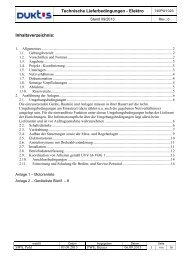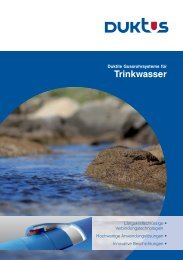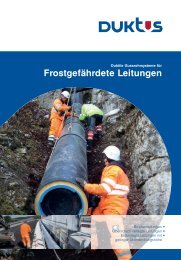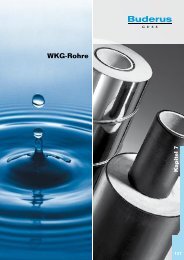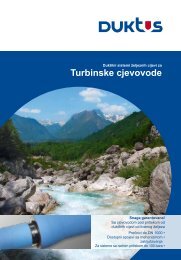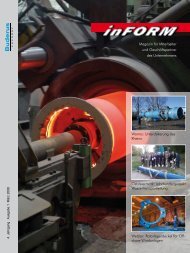inform 11.2011 e (pdf file 2 MB) - Duktus
inform 11.2011 e (pdf file 2 MB) - Duktus
inform 11.2011 e (pdf file 2 MB) - Duktus
Create successful ePaper yourself
Turn your PDF publications into a flip-book with our unique Google optimized e-Paper software.
PAGE 4 | INFORM NO. 3 / 2011<br />
WKG pipes for maintaining the temperature<br />
of drinking water<br />
USED TWICE IN ThE CONSTRUCTION Of ThE NESSELGRUND BRIDGE TO ThE SOUTh Of POTSDAm<br />
Connection and pulling-in of the WKG pipes<br />
During the construction of the new Nesselgrund<br />
bridge in the federal state of Brandenburg, <strong>Duktus</strong><br />
WKG pipes are being used to carry the<br />
drinking water in the bridge pipelines.<br />
Between Michendorf and Potsdam, the capital<br />
of the state of Brandenburg, federal highway B2<br />
crosses a multi-track Federal German Railways<br />
railway line by the Nesselgrund bridge. The<br />
bridge was about 60 years old, and was no<br />
longer equal to the present-day volume of traffic,<br />
or to the higher stresses caused by increased<br />
vehicle weights, nor were the facilities for carrying<br />
services state of the art. A new bridge had<br />
to be built. Brandenburg’s State Highways Authority<br />
has invested 2.7 million Euros in building<br />
the bridge and the construction work began in<br />
February 2011. The access road to Potsdam<br />
carries a lot of traffic and to keep this road<br />
open, a two-lane temporary steel bridge 80 metres<br />
long has been built. This bridge has also<br />
had to take all the facilities for carrying services.<br />
<strong>Duktus</strong> sales manager Lutz Rau explains the<br />
situation: “In the course of this construction operation,<br />
an existing DN 300 drinking water pipeline<br />
needed to be relocated temporarily and will<br />
need to be re-installed once the new bridge has<br />
been completed. During the construction<br />
phase, a tubular steel structure 550 millimetres<br />
in diameter suspended from the interim bridge<br />
is holding the pipeline. The planners opted for<br />
<strong>Duktus</strong> heat-compensating cast iron pipes<br />
(WKG) with BLS®/VRS®-T joints and with fully<br />
galvanized folded spiral-seam outer tubing. This<br />
enables any possibility of the water pipeline<br />
freezing to be ruled out even if the water remains<br />
stationary for a protracted period, as it<br />
would for example in the event of a possible<br />
breakdown, or even if there is an extreme frost.<br />
The flexible positive-locking BLS®/VRS®-T restrained<br />
joints also compensate safely for different<br />
temperature-related differences in length<br />
between the pipeline and the structure of the<br />
bridge and rule out any threats not only to safe<br />
operation but also to the German Railways line<br />
crossing below the bridge.”<br />
It was not only price and availability that were<br />
crucial to the placing of the order but also the<br />
extensive extra technical work that <strong>Duktus</strong> does.<br />
Employees of <strong>Duktus</strong>’s Applications Engineering<br />
Division at Wetzlar were even involved in the<br />
initial discussions on construction. All the com-<br />
The pipes laid were <strong>Duktus</strong> DN 300 heat-compensating ductile iron pipes (WKG) with BLS®/VRS®-T-restrained joints<br />
panies involved in the operation took part in<br />
these discussions, including Energie und Wasser<br />
Potsdam GmbH (EWP) which is responsible for<br />
the drinking water supply. Georgios Moutroupidis<br />
took charge of the on-site instruction of the laying<br />
personnel belonging to the Berger Bau company,<br />
and Lutz Rau assisted the team with the fitting<br />
of the traction head loaned by <strong>Duktus</strong> by providing<br />
the appropriate laying tools. As expected, the<br />
actual connection of the easy to handle BLS®/<br />
VRS®-T restrained joints and the pulling-in by<br />
steel cable of the connected pipes fitted with<br />
skids for sliding went off without any problems,<br />
so the 84 metre long bridge pipeline was quickly<br />
installed. After the pressure test and passing the<br />
hygiene inspection, the section of pipeline was<br />
connected to the old pipeline by prefabricated<br />
angle connections.<br />
The interim pipeline will be supplying the population<br />
to the south of Potsdam with their hygienically<br />
clean water until May 2012. The new Nesselgrund<br />
bridge will then have been completed and<br />
a new drinking water pipeline will take over from<br />
the interim one. <strong>Duktus</strong> will also be supplying the<br />
pipes for that.<br />
<strong>Duktus</strong> applications engineer Georgios Moutroupidis giving<br />
instruction on laying<br />
The two-lane temporary bridge approx. 80 metres long allows<br />
through traffic to continue during the construction work



